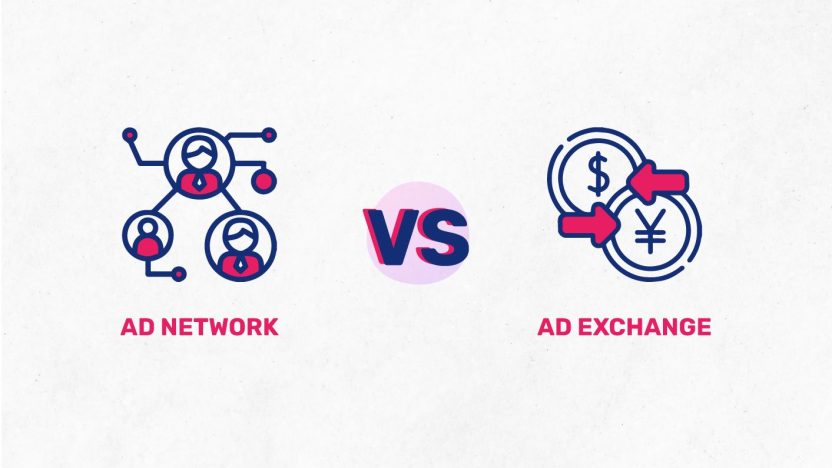Ser publisher es, esencialmente, poner tu aplicación a la orden de la publicidad programática y recibir buenas ganancias. Sin embargo, a la hora de monetizar es común preguntarse cuál es la vía más rentable para colocar tu inventario de anuncios, lo que nos lleva a comparar entre ad network vs ad Exchange. ¿Cuál reporta más ganancias?
Para responder esa pregunta, necesitamos comprender cómo nacieron estos entornos para la colocación de anuncios, cuál es su lógica de operación y hasta qué punto son espacios rentables para ti. Cuando comprendas el alcance de cada una, perfeccionarás tus planes de monetización.
La historia de las ad network vs ad Exchange: del caos a la organización de la publicidad programática
Contar con las ad network y con las ad exchange no es un capricho. Es resultado de la evolución del ecosistema de la publicidad programática, que progresivamente fue avanzando hacia esquemas claros y transparentes para advertisers y publishers.
Cuando internet comenzó a crecer como un espacio para la publicidad, al inicio de la década de 2000, la colocación de anuncios se volvió un reto. Pasamos de entornos más controlados a un espacio con mayor alcance. Anunciantes y editores entraron en pánico: ¿cómo llevar el control de los anuncios sin perderles el rastro? ¿Cómo garantizar un adecuado retorno de la inversión?
Eran tiempos de transformación y de desafíos, que demandaban acciones inmediatas. La respuesta vino a través de la intermediación, con la creación de la figura de las ad network o redes publicitarias. Básicamente, funcionan como agentes entre anunciantes y editores. Así, gestionan la oferta y demanda de anuncios.
Esto supuso un alivio temporal a las angustias del entorno publicitario digital en aquel tiempo. Los retos, sin embargo, no demoraron en aparecer: varios editores tenían dificultades para colocar por completo su inventario de anuncios. Era un problema, especialmente en un entorno donde otras formas de monetizar todavía eran incipientes.
¿Qué podía hacerse? ¿Cómo optimizar la colocación de anuncios para garantizar la sostenibilidad de la publicidad programática? La respuesta vino con la activación de las ad exchange o redes de intercambio de anuncios. En lugar de intermediar, esta red se encarga de facilitar el intercambio directo entre advertisers y publishers, mediante transacciones en tiempo real. Así, nació una alternativa para colocar el inventario de anuncios que no era vendido.
Con el nacimiento de las redes de intercambio de anuncios se consolida el desarrollo de la publicidad programática. Esto supuso, además, el perfeccionamiento de los mecanismos de relación de los anunciantes y los editores, a través de las plataformas del lado de la demanda (DSP) y del lado de la oferta (SSP).
¿Cómo distinguir a una ad network de un ad exchange?
La diferencia radica en la forma en que operan estas redes. Una ad network media entre la oferta de espacios para colocar anuncios y la demanda de anunciantes. ¿Cómo lo hace? Agrupando los inventarios de acuerdo con criterios contextuales (procura que el anuncio sea afín a la naturaleza del publisher), demográficos, por audiencias, formato de anuncios, entre otros criterios.
Con esa clasificación, desarrolla el proceso de colocación de anuncios para una coincidencia efectiva entre las creatividades y espacios publicitarios. Si pudiéramos compararlos con un comerciante, podríamos definir a las redes publicitarias como unos mayoristas que distribuyen las impresiones ofertadas por los editores entre una comunidad de anunciantes.
Dado ese alcance, se reconoce la relevancia de las ad network para el éxito de la publicidad programática. Basta ver los resultados obtenidos por plataformas como Google AdMob para comprender su alcance y valor.
En cambio, un ad exchange es un espacio de negociación entre editores y anunciantes. Para ello, el inventario publicitario se oferta en tiempo real a través de pujas, por lo que el precio de tu inventario puede fluctuar. Todo esto es posible a través de aplicaciones diseñadas para este proceso, que eliminan la figura del intermediario y hacen transparentes las transacciones.
De acuerdo con los parámetros que manejen los advertisers y las agencias publicitarias, están dispuestos a hacer mejores ofertas si colocar sus anuncios en tu aplicación les resulta más conveniente.
¿Cómo vender tu inventario de anuncios en un ad network y un ad Exchange?
Al explorar cómo operan estas redes, podrás comprender mucho mejor cuáles son las ventajas que te ofrecen como editor y qué puedes esperar en términos de ganancias. Además, entenderás cuál es la lógica que aplican advertisers y otros actores involucrados en la compra de impresiones para la publicidad programática.
“Soy el vendedor de tu inventario”: así funciona una ad network
Cuando te dijimos que una red publicitaria operaba como un mayorista, no estábamos exagerando. Al igual que un vendedor de grandes volúmenes de productos, una red publicitaria clasifica la oferta de espacios publicitarios existente y la conecta con los advertisers que mejor pueden aprovechar esos inventarios.
Exactamente, ¿cómo lo hace? Mediante un proceso de mediación entre publishers y advertisers. Ellos no estarán directamente en contacto a lo largo de este proceso de negociación que, en concreto, se desarrolla así:
#1 Editores y anunciantes deben conectar sus plataformas con la red publicitaria
Cada actor la configurará de acuerdo con sus intereses. Los publishers la integrarán a su aplicación para facilitar el acceso a su inventario de anuncios, mientras que los advertisers programarán sus campañas publicitarias por esa vía.
#2 Los publishers definen cuál es el inventario que quieren ofrecer
Establecen cuál es la cantidad de impresiones que desea colocar a disposición de la red publicitaria, así como la oferta mínima para este inventario. Por lo general, ofrecen por esa vía su inventario premium.
#3 Los advertisers configuran sus campañas
Establecen la audiencia a la que quieren llegar, el tipo de creatividad que quieren difundir, el presupuesto dispuesto y la modalidad de pago: costo por clic, por visualización o por instalación entre otros.
#4 La red estudia las características de inventarios publicitarios y anuncios para hacerlos coincidir
De esta forma, garantiza la colocación de anuncios relevantes para públicos afines según su geolocalización, edad, hábitos y otros datos de segmentación.
#5 Campañas y espacios publicitarios quedan conectados
Una vez se compra el inventario de anuncios de un publisher, los anuncios previstos por los advertisers comenzarán a mostrarse en la aplicación. El éxito se medirá según el coste efectivo por cada mil impresiones (eCPM), en el caso del editor, y en el Retorno de la Inversión (ROI), en el caso del anunciante.
#6 La red publicitaria cobra una comisión por su trabajo de mediación
Los editores
y los anunciantes pagan a la red por su gestión.
¿Cuántos tipos de ad networks existen?
En la publicidad programática se reconoce la existencia de redes publicitarias horizontales, reconocidas por su amplio alcance entre publishers y advertisers; premium, para editores de máximo nivel; verticales, ideadas para llegar a editores de relevancia, y especializadas en un tipo de formato.
Subasta en milisegundos: cómo opera una ad exchange
Al analizar el comportamiento de una ad network vs una ad Exchange, veremos que las redes de intercambio de anuncios se comportan como espacios de negociación directa para la colocación de creatividades. En lugar de un vendedor, existe una plataforma donde se sellan acuerdos en cuestión de milisegundos.
¿Cómo lo hace? A través de subastas en tiempo real o Real Time Bidding (RTB). En ella participan las SSP, donde los editores ponen a disposición su inventario de anuncios, y las DSP, donde los anunciantes gestionan la compra de impresiones para sus campañas.
En específico, el trabajo de una ad Exchange se gestiona así:
- #1 Los publishers vinculan su aplicación con un SSP: de esta forma, colocan su inventario de anuncios a la orden de los procesos de subasta que se dan en el ecosistema de la publicidad programática.
- #2 Los advertisers gestionan sus campañas a través de los DSP: establece los criterios de segmentación, los tipos de ads formats que manejarán y el presupuesto disponible. Así, la compra de impresión se desarrollará de forma automatizada.
- #3 Ante cada oportunidad de servir un anuncio, se dará una subasta en tiempo real: al ingresar un usuario a una aplicación, se activa de inmediato un sistema de pujas entre anunciantes. La impresión se venderá al mejor postor, que tendrá la posibilidad de colocar su creatividad en esa plataforma.
En ese proceso son claves los criterios de segmentación de anuncios y su coincidencia con el tipo de usuarios de la aplicación que oferta sus impresiones.
- #4 Hecha la subasta y cerrada la transacción, la creatividad es mostrada al usuario: aunque no lo creas, esto ocurre en milisegundos. Quienes emplean tu aplicación no pueden imaginar que ese anuncio que acaban de ver está ahí luego de una intensa puja.
¿Cuántos tipos de ad Exchange puedo conseguir?
Al ser un espacio donde coinciden y se analizan las necesidades de las SSP y las DSP, las ad Exchange tienen el reto de manejar altos volúmenes de oferta y demanda. Al mismo tiempo, deben satisfacer las necesidades de aquellos advertisers que quieren anunciar en espacios publicitarios premium.
Para responder a ese desafío, hoy es posible conseguir dos tipos de redes de intercambio de anuncios:
Ad Exchange abierta
Es aquella que ofrece una amplia oferta de inventarios de anuncios. Es útil cuando los advertisers quieren ampliar la presencia de sus campañas en múltiples plataformas. Sin embargo, en términos de transparencia, hay actores del ecosistema de la publicidad programática que tienen sus reservas con esas redes, al temer que existan riesgos de fraude.
Ad Exchange cerrada
En esta, la venta del inventario de anuncios es mucho más controlada. Participan en las pujas advertisers y agencias específicas, definidas a través de una lista de preferencias. Esto garantiza niveles más altos de confiabilidad y transparencia.
¿Cuál genera más revenue? Ad network vs ad Exchange
Ya conoces cómo funcionan las redes publicitarias y las redes de intercambio de anuncios. Como ves, las posibilidades de monetización están sujetas a las dinámicas particulares de cada una.
De acuerdo con Spiceworks, las principales ventajas que te ofrecen las ad networks radican en el manejo de precio de tu inventario de anuncios. Incluso, puedes venderlo en una cifra superior al precio base de tu inventario, pues los anunciantes no tienen mayor margen de negociación.
Las facilidades en el manejo del precio de tus impresiones contrastan con la principal desventaja de una red publicitaria: desconoces las características del comprador de tu inventario. Esto puede incidir en la reputación de tu aplicación y, por ende, afectar tus posibilidades de monetizar.
Estos riesgos no se corren con los ad Exchange, pues las transacciones son transparentes para editores y anunciantes. Además, si tienes inventario remanente, tienes más posibilidades de colocarlo. Sin embargo, el precio de esas impresiones depende de los advertisers.
Entonces, ¿qué te reporta más ganancias?
Generar más ingresos por monetización dependerá de las características de tu aplicación, tus planes como publisher y tu experiencia en el mundo de la publicidad programática. Si estás empezando, quieres comenzar a construirte un nombre como editor, ofrecer tu inventario premium y mantener el precio de tu inventario, entonces el camino será una ad network.
Ahora, si quieres apuntar a advertisers con un perfil más preciso, aumentar tu reputación y colocar tu inventario adicional de anuncios, tu camino son las ad exchange. Es una vía segura para tus ganancias y tu tranquilidad.
En definitiva, más que fórmulas preestablecidas, el éxito de tu elección dependerá de una evaluación eficaz de las potencialidades de tu aplicación como espacio publicitario.
¿Ad network vs Ad Exchange? Resuelve el dilema con Wortise e incrementa tus ganancias
¡Hola, publisher! Tu inventario de anuncios es tu mejor capital. Usa las ventajas de tu aplicación para llegar a advertisers premium, incrementar tus ganancias y consolidar tu prestigio como editor junto a nosotros. Tú tienes el potencial; nosotros, la experiencia.
En Wortise te ayudamos a incrementar tus ingresos como editor con nuestra plataforma de redes de anuncios avanzada con más de 100 Ad Networks.
Brindamos soporte personalizado, el eCPM más alto del mercado y acompañamiento con tácticas para maximizar tus ganancias.




